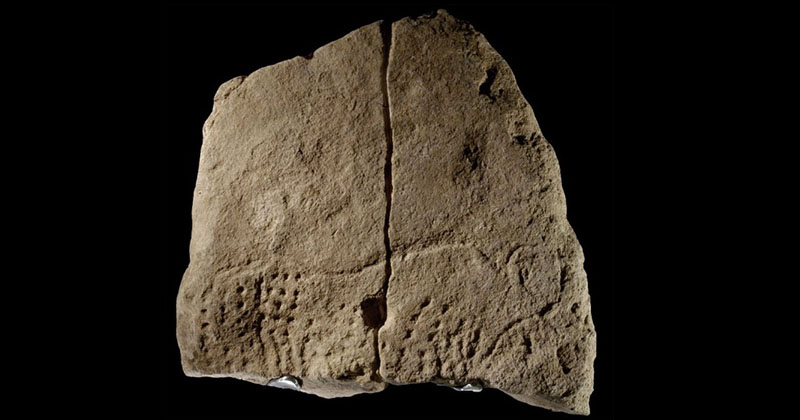The ancient roots of European civilization have been highlighted once again with the announcement by scientists that radio carbon dating has revealed that a massive piece of rock art discovered earlier in southwestern France is at least 38,000 years old—making it one of the oldest such examples ever found on the Continent.

The study, published in the January 24, 2017 edition of the Quaternary International journal, and titled “A new Aurignacian engraving from Abri Blanchard, France: Implications for understanding Aurignacian graphic expression in Western and Central Europe,” said that the engraving “sheds new light on regional patterning of art and ornamentation across Europe.”
The rock—which shows a group of aurochs (an extinct species of cattle) and dozens of small dots, formed part of the Aurignacian culture, the first identified Homo sapiens in Europe.
It was discovered in 2012, when a group of archaeologists turned over a broken block of limestone on the floor of a rock shelter in southwestern France.
The slab comes from a partially collapsed rock shelter called Abri Blanchard, where groups of hunter-gatherers would have congregated during the winter.
The artists at Abri Blanchard chose a diverse array of artistic subjects, from horses and cats to geometric designs such as rings.
In addition to the aurochs carving, researchers found hundreds of stone tools and stone tool fragments, as well as animal bones, mostly from reindeer. They also found decorative bone, including an ivory bead and a pierced fox tooth.
This 65-foot-long (20 meters) shelter is located near the small town of Sergeac in France’s Vézère Valley, a region famous for having some of Europe’s oldest examples of cave art.
Aurignacian images of aurochs have been found at other sites, such as Chauvet Cave, also in France. Aligned dots have also been seen before on Aurignacian objects such as mammoth-tooth plaques and ivory pendants, but the combination of this design with an animal figure is “exceptional,” the researchers wrote.
The new study’s summary said that “in the excitement of the widely publicized new finds of Aurignacian art from Chauvet, from the Swabian Jura and from as far afield as Pestera Coliboaia in Romania, it has almost been forgotten that a rich corpus of Aurignacian wall painting, engraving and bas-relief sculpture had been recognized and studied before World War I in the Vézère Valley of SW France.
“Scientific knowledge of the chronological and cultural context of that early-discovered graphic record has been limited by the crude archaeological methods of that pioneering era, and the loss and dispersal of many of the works discovered.
“In 2011, we launched new excavations and a re-analysis of one of the key sites for such early discoveries, the collapsed rock shelter of Abri Blanchard. In 2012, we discovered in situ a limestone slab engraved with a complex composition combining an aurochs and dozens of aligned punctuations.
“This new find, recovered by modern methods and dated by molecular filtration and Hydroxyproline 14C, provides new information on the context and dating of Aurignacian graphic imagery in SW France and its relationship to that of other regions.
“The support is not a fragment of collapsed shelter ceiling and is situated in the midst of quotidian occupational debris. The image shows significant technical and thematic similarities to Chauvet that are reinforced by our reanalysis of engraved slabs from the older excavations at Blanchard.
“The aligned punctuations find their counterparts at Chauvet, in the south German sites and on several other objects from Blanchard and surrounding Aurignacian sites.
“In sum, we argue that dispersing Aurignacian groups show a broad commonality in graphic expression against which a certain number of more regionalized characteristics stand out, a pattern that fits well with social geography models that focus on the material construction of identity at regional, group and individual levels.”